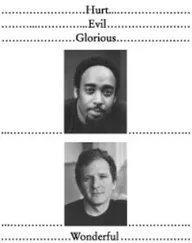Malcolm Gladwell - The Tipping Point
Здесь есть возможность читать онлайн «Malcolm Gladwell - The Tipping Point» весь текст электронной книги совершенно бесплатно (целиком полную версию без сокращений). В некоторых случаях можно слушать аудио, скачать через торрент в формате fb2 и присутствует краткое содержание. Город: Boston, New York, London, Год выпуска: 2000, ISBN: 2000, Издательство: LITTLE, BROWN AND COMPANY, Жанр: Культурология, Психология, на английском языке. Описание произведения, (предисловие) а так же отзывы посетителей доступны на портале библиотеки ЛибКат.
- Название:The Tipping Point
- Автор:
- Издательство:LITTLE, BROWN AND COMPANY
- Жанр:
- Год:2000
- Город:Boston, New York, London
- ISBN:0-316-31696-2
- Рейтинг книги:3 / 5. Голосов: 1
-
Избранное:Добавить в избранное
- Отзывы:
-
Ваша оценка:
- 60
- 1
- 2
- 3
- 4
- 5
The Tipping Point: краткое содержание, описание и аннотация
Предлагаем к чтению аннотацию, описание, краткое содержание или предисловие (зависит от того, что написал сам автор книги «The Tipping Point»). Если вы не нашли необходимую информацию о книге — напишите в комментариях, мы постараемся отыскать её.
The Tipping Point — читать онлайн бесплатно полную книгу (весь текст) целиком
Ниже представлен текст книги, разбитый по страницам. Система сохранения места последней прочитанной страницы, позволяет с удобством читать онлайн бесплатно книгу «The Tipping Point», без необходимости каждый раз заново искать на чём Вы остановились. Поставьте закладку, и сможете в любой момент перейти на страницу, на которой закончили чтение.
Интервал:
Закладка:
Many patients who attempt suicide are drawn from a section of the community in which self-aggression is generally recognized as a means of conveying a certain kind of information. Among this group the act is viewed as comprehensible and consistent with the rest of the cultural pattern… If this is true, it follows that the individual who in particular situations, usually of distress, wishes to convey information about his difficulties to others, does not have to invent a communicational medium de novo… The individual within the "attempted suicide subculture" can perform an act which carries a preformed meaning; all he is required to do is invoke it. The process is essentially similar to that whereby a person uses a word in a spoken language.
This is what is going on in Micronesia, only at a much more profound level. If suicide in the West is a kind of crude language, in Micronesia it has become an incredibly expressive form of communication, rich with meaning and nuance, and expressed by the most persuasive of permission-givers. Rubinstein writes of the strange pattern of suicides on the Micronesian island of Ebeye, a community of about 6,000. Between 1955 and 1965, there wasn't a single case of suicide on the entire island. In May 1966, an eighteen-year-old boy hanged himself in his jail cell after being arrested for stealing a bicycle, but his case seemed to have little impact. Then, in November of 1966, came the death of R., the charismatic scion of one of the island's wealthiest families. R. had been seeing two women and had fathered a one-month-old child with each of them. Unable to make up his mind between them, he hanged himself in romantic despair. At his funeral, his two lovers, learning of the existence of the other for the first time, fainted on his grave.
Three days after R.'s death, there was another suicide, a twenty-two-year-old male suffering from marital difficulties, bringing the suicide toll to two over a week in a community that had seen one suicide in the previous twelve years. The island's medic wrote: "After R. died, many boys dreamed about him and said that he was calling them to kill themselves." Twenty-five more suicides followed over the next twelve years, mostly in clusters of three or four over the course of a few weeks. "Several suicide victims and several who have recently attempted suicide reported having a vision in which a boat containing all the past victims circles the island with the deceased inviting the potential victims to join them," a visiting anthropologist wrote in 1975. Over and over again, the themes outlined by R. resurfaced. Here is the suicide note of M., a high school student who had one girlfriend at boarding school and one girlfriend on Ebeye, and when the first girlfriend returned home from school, two girlfriends at once — a complication defined, in the youth subculture of Ebeye, as grounds for taking one's own life: "Best wishes to M. and C. [the two girlfriends]. It's been nice to be with both of you." That's all he had to say, because the context for his act had already been created by R. In the Ebeye epidemic, R. was the Tipping Person, the Salesman, the one whose experience "overwrote" the experience of those who followed him. The power of his personality and the circumstances of his death combined to make the force of his example endure years beyond his death.
Does teen smoking follow this same logic? In order to find out more about the reasons teenagers smoke, I gave several hundred people a questionnaire, asking them to describe their earliest experiences with cigarettes. This was not a scientific study. The sample wasn't representative of the United States. It was mostly people in their late twenties and early thirties, living in big cities. Nonetheless the answers were striking, principally because of how similar they all seemed. Smoking seemed to evoke a particular kind of childhood memory — vivid, precise, emotionally charged. One person remembers how she loved to open her grandmother's purse, where she would encounter "the soft smell of cheap Winstons and leather mixed with drugstore lipstick and cinnamon gum." Another remembers "sitting in the back seat of a Chrysler sedan, smelling the wonderful mixture of sulfur and tobacco waft out the driver's window and into my nostrils." Smoking, overwhelmingly, was associated with the same thing to nearly everyone: sophistication. This was true even of people who now hate smoking, who now think of it as a dirty and dangerous habit. The language of smoking, like the language of suicide, seems incredibly consistent. Here are two responses, both describing childhood memories:
My mother smoked, and even though I hated it — hated the smell — she had these long tapered fingers and full, sort of crinkly lips, always with lipstick on, and when she smoked she looked so elegant and devil-may-care that there was no question that I'd smoke someday. She thought people who didn't smoke were kind of gutless. Makes you stink, makes you think, she would say, reveling in how ugly that sounded.
My best friend Susan was Irish-English. Her parents were, in contrast to mine, youthful, indulgent, liberal. They had cocktails before dinner. Mr. O'Sullivan had a beard and wore turtlenecks. Mrs. O'Sullivan tottered around in mules, dressed slimly in black to match her jet-black hair. She wore heavy eye-makeup and was a little too tan and always, virtually always, had a dangerously long cigarette holder dangling from her manicured hands.
This is the shared language of smoking, and it is as rich and expressive as the shared language of suicide. In this epidemic, as well, there are also Tipping People, Salesmen, permission-givers. Time and time again, the respondents to my survey described the particular individual who initiated them into smoking in precisely the same way.
When I was around nine or ten my parents got an English au pair girl, Maggie, who came and stayed with us one summer. She was maybe twenty. She was very sexy and wore a bikini at the Campbells' pool. She was famous with the grownup men for doing handstands in her bikini. Also it was said her bikini top fell off when she dove — Mr. Carpenter would submerge whenever she jumped in. Maggie smoked, and I used to beg her to let me smoke too.
The first kid I knew who smoked was Billy G. We became friends in fifth grade, when the major distinctions ill our suburban N.J. town-jocks, heads, brains — were beginning to form. Billy was incredibly cool. He was the first kid to date girls, smoke cigarettes and pot, drink hard alcohol and listen to druggy music. I even remember sitting upstairs in his sister's bedroom — his parents were divorced (another first), and his mom was never home — separating the seeds out of some pot on the cover of a Grateful Dead album… The draw for me was the badness of it, and the adultness, and the way it proved the idea that you could be more than one thing at once.
The first person who I remember smoking was a girl named Pam P. I met her when we were both in the 10th grade. We rode the school bus together in Great Neck, L.I., and I remember thinking she was the coolest because she lived in an apartment. (Great Neck didn't have many apartments.) Pam seemed so much older than her 15 years. We used to sit in the back of the bus and blow smoke out the window. She taught me how to inhale, how to tie a man-tailored shirt at the waist to look cool, and how to wear lipstick. She had a leather jacket. Her father was rarely home.
There is actually considerable support for this idea that there is a common personality to hard-core smokers. Hans Eysenck, the influential British psychologist, has argued that serious smokers can be separated from nonsmokers along very simple personality lines. The quintessential hard-core smoker, according to Eysenck, is an extrovert, the kind of person who
Читать дальшеИнтервал:
Закладка:
Похожие книги на «The Tipping Point»
Представляем Вашему вниманию похожие книги на «The Tipping Point» списком для выбора. Мы отобрали схожую по названию и смыслу литературу в надежде предоставить читателям больше вариантов отыскать новые, интересные, ещё непрочитанные произведения.
Обсуждение, отзывы о книге «The Tipping Point» и просто собственные мнения читателей. Оставьте ваши комментарии, напишите, что Вы думаете о произведении, его смысле или главных героях. Укажите что конкретно понравилось, а что нет, и почему Вы так считаете.










